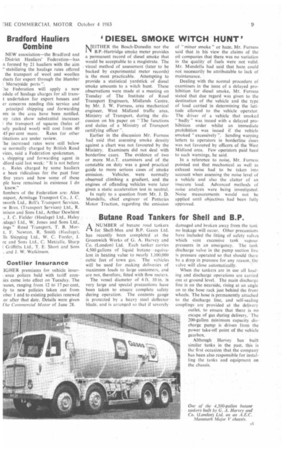DIESEL SMOKE WITCH HUNT'
Page 11

If you've noticed an error in this article please click here to report it so we can fix it.
MEITHER the Bosch-Dunedin nor the B.?.-Hartridge smoke meter provides a permanent record of diesel smoke that would be acceptable to a magistrate. The visual method of assessment (later to be backed by experimental meter records) is the most practicable. Attempting to provide a statistical yardstick of diesel smoke amounts to a witch hunt, These observations were made at a meeting on Tuesday of The Institute of Road Transport Engineers. Midlands Centre, by Mr. J. W. Furness, area mechanical engineer, West Midland traffic area. Ministry of Transport, during the discussion on his paper on " Thc functions and duties of a Ministry of Transport certifying officer ".
Earlier in the discussion Mr. Furness had said that assessing smoke density against a chart was not favoured by the Ministry. Examiners did not deal with borderline cases. The evidence of two or more M.o.T. examiners and of the constable on duty was a good practical guide to more serious cases of smoke emission. Vehicles, were normally observed climbing a gradient, and the engines of offending vehicles were later given a static acceleration test in neutral.
In reply to a question from Mr. J. D. Mundella, chief engineer of Potteries Motor Traction, regarding the emission of "minor smoke" or haze, Mr. Furness said that in his view the claims of the oil companies that there was no variation in the quality of fuels were not valid. Mr. Mundella had said that haze could not necessarily be attributable to lack of maintenance.
Dealing with the normal procedure of examiners in the issue of a delayed prohibition for diesel smoke, Mr. Furness stated that due regard was given to the destination of the vehicle and the type of load carried in determining the latitude allowed to the vehicle operator. The driver of a vehicle that smoked " badly " was issued with a delayed prohibition order whilst an immediate prohibition was issued if the vehicle smoked " excessively ". Sending warning letters to operators in borderline Cases was not favoured by officers of the West Midland area. Few operators paid heed to such warnings, he said.
In a reference to noise, Mr. Furness pointed out that mechanical as well as exhaust noise had to be taken into account when assessing the noise level of a vehicle and also the clatter of an insecure load. Advanced methods of noise analysis were being investigated. Noise measurements would not be applied until objectives had been fully approved.








































































































































































